Policies
The integrated policy engines of the HiveMQ Data Hub give you the ability to build individual data governance policies that maximize the value of your data pipelines in a variety of ways.
The HiveMQ Data Hub supports two types of policies:
Data policies describe how you want the HiveMQ broker to apply a selected schema to verify the payload data of incoming MQTT messages.
Behavior policies govern how you want the HiveMQ broker to model the actions of MQTT clients across the entire lifecycle of the client.
Both data policies and behavior policies incorporate three basic concepts:
-
Matching: Specifies the matching rules the policy engine applies. For example, an MQTT topic filter or a regex pattern for client identifiers. Matching rules vary based on the type of policy. For more information, see Matching in Policy Definitions and Matching in Behavior Policies.
-
Validations: Specifies how the selected MQTT packets or behaviors are validated. For example, based on a JSON Schema.
-
Actions: Specifies a pipeline of one or more operations the outcome of the validation or the event in a transition triggers. For example, functions to log a message, increment a metric, or reroute the MQTT message. Moreover, users may even define their own functions to transform payloads (Transformation).
| The format for HiveMQ Data Hub policy specification is JSON. |
| Transformation scripts can be only executed in the action pipelines of data policies, only. Behavior policies are not yet supported. |
Data Policies
You can create and manage Data Hub data policies from the HiveMQ Control Center or with the HiveMQ REST API.
Data Policy Management with the HiveMQ Control Center
The Data Hub view in the HiveMQ Control Center provides an easy-to-use interface with everything you need to manage data policies and schemas. Our policy creation wizards offer an intuitive way to create new policies with context help and immediate feedback on policy validity.
For more information, see HiveMQ Control Center
Data Policy Management with the HiveMQ REST API
The HiveMQ Rest API provides the following methods to manage data validation policies for the HiveMQ Data Hub:
Create a Data Policy
The fields in the body of the create a new policy HTTP request determine the type of policy that is created.
| To create a new policy, all cluster nodes must run HiveMQ version 4.15.0 or higher and data validation must be enabled. For more information, see Data Hub. |
| Field | Type | Required | Description |
|---|---|---|---|
|
String |
The identifier of the policy. The ID must be unique within one HiveMQ cluster.
We recommend the use of proper namespacing. For example, |
|
|
Object |
Defines the matching rules of the policy. For more information, see Matching in Policy Definitions. |
|
|
Object |
Defines a list of the validations that are executed for all incoming MQTT messages that match MQTT topics configured in the matching definition. If no validations are present, the policy always evaluates successfully. For more information, see Validation in Policy Definitions. |
|
|
Object |
The action that defines the pipeline of operations the HiveMQ broker executes when the validation is successful. If no action is defined, no operations are executed when the policy is evaluated successfully. For more information, see Actions in Data Policy Definitions. |
|
|
Object |
The action that defines the pipeline of operations the HiveMQ broker executes when the validation is unsuccessful. If no action is defined, no operations are executed when the policy is evaluated unsuccessfully. For more information, see Actions in Data Policy Definitions. |
| Your HiveMQ broker automatically replicates the schemas and policies you create to all nodes in the HiveMQ cluster. |
{
"id": "com.hivemq.policy.coordinates",
"matching": {
"topicFilter": "coordinates/+"
},
"validation": {
"validators": [
{
"type": "schema",
"arguments": {
"strategy": "ALL_OF",
"schemas": [
{
"schemaId": "gps_coordinates",
"version": "latest"
}
]
}
}
]
},
"onFailure": {
"pipeline": [
{
"id": "logFailure",
"functionId": "System.log",
"arguments": {
"level": "WARN",
"message": "${clientId} sent an invalid publish on topic '${topic}' with result '${validationResult}'"
}
}
]
}
}Update an Existing Data Policy
The fields in the body of the update a policy HTTP request determine the type of policy that is updated.
The id of the policy and the request parameter policyId must match.
| Parameter | Type | Required | Description |
|---|---|---|---|
|
String |
The path parameter that provides the ID of the policy to update. This parameter must match the |
You cannot change the matching part of a policy once the policy is created, but it is possible to add, remove, and update the content of the validation, onSuccess, and onFailure parts of a policy.
| To update a policy, all cluster nodes must run HiveMQ version 4.17.0 or higher and data validation must be enabled. For more information, see Data Hub. |
| Field | Type | Required | Description |
|---|---|---|---|
|
String |
The identifier of the policy. The ID must be unique within one HiveMQ cluster.
We recommend the use of proper namespacing. For example, |
|
|
Object |
Defines the matching rules of the policy. The matching part of a policy cannot be updated. For more information, see Matching in Policy Definitions. |
|
|
Object |
Defines a list of the validations that are executed for all incoming MQTT messages that match MQTT topics configured in the matching definition. If no validations are present, the policy is always successfully evaluated. For more information, see Validation in Policy Definitions. |
|
|
Object |
The action that defines the pipeline of operations the HiveMQ broker executes when the validation is successful. If no action is defined, no operations are executed when the policy evaluates successfully. For more information, see Actions in Data Policy Definitions. |
|
|
Object |
The action that defines the pipeline of operations the HiveMQ broker executes when the validation is unsuccessful. If no action is defined, no operations are executed when the policy evaluates unsuccessfully. For more information, see Actions in Data Policy Definitions. |
| Your HiveMQ broker automatically replicates policies you update to all nodes in the HiveMQ cluster. |
{
"id": "com.hivemq.policy.coordinates",
"matching": {
"topicFilter": "coordinates/+"
},
"validation": {
"validators": [
{
"type": "schema",
"arguments": {
"strategy": "ALL_OF",
"schemas": [
{
"schemaId": "gps_coordinates",
"version": "latest"
}
]
}
}
]
},
"onFailure": {
"pipeline": [
{
"id": "logFailure",
"functionId": "System.log",
"arguments": {
"level": "WARN",
"message": "${clientId} sent an invalid publish on topic '${topic}' with result '${validationResult}'"
}
}
]
}
}Delete a Data Policy (REST API)
To delete a policy that is no longer in use, reference the policyId of the policy.
| If you want to delete a policy and schema, you must delete the policy that references the schema before you can delete the schema. |
| Parameter | Type | Required | Description |
|---|---|---|---|
|
String |
The path parameter that provides the ID of the policy to delete. For example, |
Get a Policy (REST API)
To view the content of an existing policy, you reference the policyId of the policy.
| To retrieve the content of a policy, all cluster nodes must run HiveMQ version 4.15.0 or higher. |
| Parameter | Type | Required | Description |
|---|---|---|---|
|
String |
The path parameter that provides the ID of the policy. |
|
|
String |
The query parameter that provides a comma-separated list of the fields to include in the response.
Allowed values are: |
Matching in Data Policies
The first section of your data policy identifies the policy and specifies the conditions the policy enforces.
The matching configuration gives you highly customizable control over which MQTT message or MQTT clients a policy influences.
|
The way HiveMQ Data Hub applies matching varies based on the type of policy. For information on how matching applies in a behavior policy, see Matching in Behavior Policies. |
Data policies implement topic-based matching that works in a similar way to MQTT topic subscriptions.
For more information, see MQTT Topic Tree & Topic Matching: Challenges and Best Practices Explained.
{
"id": "com.hivemq.policy.coordinates",
"matching": {
"topicFilter": "coordinates/+"
}
}| In HiveMQ Edge topic filters work the same way for protocol adapters. Each submission to an MQTT topic from a device will be handled through a configured topic filter. |
The example data policy matches all MQTT messages that are published along the topic tree coordinates/`. +
The ` symbol defines a single topic wildcard.
For example, MQTT messages published to coordinates/europe, coordinates/africa, and coordinates/asia.
Based on the + single topic wildcard, publishes to multi-level topics such as coordinates/usa/north are not part of the topic tree.
For more information, see MQTT Topics, Wildcards, and Best Practices.
Data Policy Execution in a Topic Tree
The following examples illustrate how policies and topic filters interact.
MQTT topics are arranged in a hierarchical tree structure, similar to the file system of a computer.
A forward slash / separates each level of the tree.
|
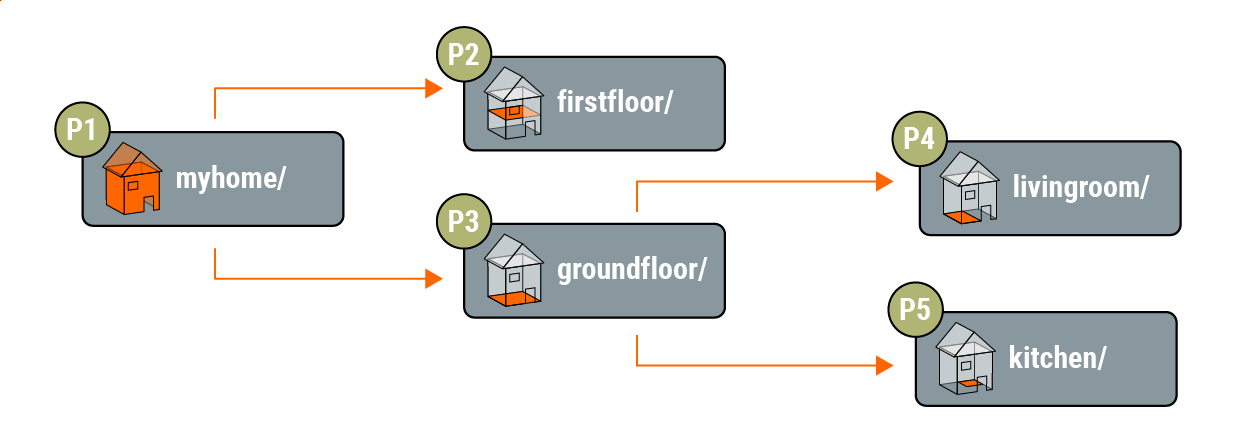
The example diagram depicts a topic tree with a top-level topic called myhome, four subtopics, and five policies.
-
Policy
P1is configured to match the topic filtermyhome. -
Policy
P2is configured to match the topic filtermyhome/firstfloor. -
Policy
P3is configured to match the topic filtermyhome/groundfloor. -
Policy
P4is configured to match the topic filtermyhome/groundfloor/livingroom. -
Policy
P5is configured to match the topic filtermyhome/groundfloor/kitchen.
| Topic | Policies Executed |
|---|---|
|
|
|
|
|
|
|
|
|
|
It is also possible to add policies to match wildcard topic filters.
MQTT supports two types of wildcard characters.+ matches any single-level of the topic tree. # matches multiple levels of the topic tree.
|
-
Policy
P6is configured to match the single topic wildcardmyhome/+. -
Policy
P7is configured to match the multi-level wildcard topicmyhome/#.

| Topic | Policies Executed |
|---|---|
|
|
|
|
|
|
|
|
|
|
In the HiveMQ Data Hub data validation feature, policies execute from the least specific :
-
The policies along a topic tree execute from the least specific to the most specific.
-
A multi-level wildcard
#executes before a single-level wildcard. -
A single-level wildcard
+executes before a single topic segment.
For example, in a use case that aims to simplify data handling, a wildcard can be used to ensure that all MQTT message that all MQTT message payloads are JSON formatted.
Using the example topic tree, policy P1 can be defined with a multi-level topic filter # and a simple JSON schema validation.
Since every MQTT message to any MQTT topic must pass P1, all MQTT messages must be JSON.
Behavior Policies
Behavior Policies give you the ability to model the behavior of your MQTT clients throughout the entire lifecycle of the client. Client behavior can be checked against a defined behavior model to determine whether the client is acting in the expected manner. The behavior model builds a level of control on top of the MQTT protocol with a state machine that checks how the client works with the HiveMQ broker. For example, a behavior policy can enforce the manner in which a specific sequence of messages are published.
Each behavior model defines a set of states a client can transition to.
Actions can be executed in reaction to the transitions of the states.
For example, after a certain sequence of MQTT packets a publish packet is allowed which may enforce that a client is properly initialized.
In many cases, it is relevant to maintain an overview of your client behavior.
Behavior models allow you to control how your MQTT clients use the MQTT protocol.
The behavior data can be a useful supplement to the standard data that an MQTT broker publishes.
In contrast to data policies, behavior policies are instantiated right at the beginning of a client connection.
Multiple of those behavior models can be instantiated per client.
HiveMQ Data Hub currently offers three behavior models: Mqtt.events, Publish.quota, and, Publish.duplicates.For more information, see Data Hub Behavior Models. |
A behavior policy definition is defined over the following fields:
-
Matching: Defines to which clients a behavior policy applies.
-
Behavior Models: Specifies the instantiated behavior model along with any necessary additional arguments for a more specific definition.
-
States & Transitions: Defines a list of actions according to the state transitions of the behavior model. Users can easily customize client behavior such as special observability through custom metrics to client disconnection.
You can create and manage Data Hub Behavior policies from the HiveMQ Control Center or with the HiveMQ REST API.
{
"id": "example-behavior-policy",
"matching": {
"clientIdRegex": ".*"
},
"behavior": {
"id": "Publish.quota",
"arguments": {
"minPublishes": 5,
"maxPublishes": -1
}
},
"onTransitions": [
{
"fromState": "Any.*",
"toState": "Violated",
"Mqtt.OnInboundPublish": {
"pipeline": [
{
"id": "count-probes",
"functionId": "Metrics.Counter.increment",
"arguments": {
"metricName": "repetitive-messages-count",
"incrementBy": 1
}
},
{
"id": "log",
"functionId": "System.log",
"arguments": {
"message": "Client is sending the same payload",
"level": "INFO"
}
},
{
"id": "drop",
"functionId": "Mqtt.drop",
"arguments": {}
}
]
}
}
]
}The policy matches every clientId since the configured regular expression matches every UTF-8 string.
A behavior model Publish.quota is instantiated and configured via the arguments object.
The onTransitions object references one transition from any state of the behavior model (denoted via Any.*) to the state Violated defined in the model as well.
The transition is uniquely specified by the two states and the MQTT PUBLISH (denoted by Mqtt.OnInboundPublish) and an action pipeline is executed.
In this case, a custom metric is created and incremented, a log message is printed, and the actual MQTT PUBLISH is dropped, once this transition is executed.
In practice, once the behavior model detects a violation, in this case, transitions from any state to Violated, the metric is increased, a message is logged, and the message is not passed to the intended topic.
The following sections offer more details on how to define behavior policies
| The behavior policy engine handles the MQTT traffic before it enters the extension system. |
Matching in Behavior Policies
Behavior policies are instantiated via a definition of the clients to which the policy applies.
Client are matched by a regular expression for their client identifier.
For example, temperature-.* to match any client with an identifier starting with temperature-.
| Different behavior policies can use the same regular expression. When more than one behavior policy references the same regular expression, multiple behavior models are instantiated per client connection. |
Behavior Models
The behavior model describes which model is used in the policy. Additional arguments may configure the model as shown in the introductory example.
A behavior model is referenced by its name. The following behavior models are currently available:
Each behavior model implements a finite state machine (FSM) consisting of states and transitions.
-
State: A state has a unique name within the behavior model, such as
Connected. -
Transitions: The state machine transitions from a state to another state via its transition based on a certain condition or an event.
If a behavior model makes a state transition. additional actions can be executed.
Transitions & States
As previously mentioned, a behavior model defines the transition between states. Additional actions can be executed for state transitions. Each model defines its own states, whereas there are four different categories of states.
-
Initial: The initial state from which the behavior model starts. -
Intermediate: Models a category of intermediate states, for example,Connected. -
Failed: Models a category of states that indicate misbehavior, for example,Violated. -
Success: Models a category of states that indicate a correct behavior, for example,Good.
The Failed and Success states are terminal states, which means a behavior model cannot transition from these states anymore.
All other states are non-terminal states.
Wildcard States
To catch a set of states, wildcards are provided via:
-
Any.*: Matches all states -
Any.Success. Matches allSuccessstates -
Any.Failed. Matches allFailedstates
Supported Events
-
Mqtt.OnInboundConnect: This event is triggered when a client has initiated the connection via a CONNECT packet. -
Mqtt.OnInboundPublish: An event that is triggered when a client sends a PUBLISH packet. -
Mqtt.OnInboundSubscribe: An event that is triggered when a client sends a SUBSCRIBE packet. -
Mqtt.OnInboundDisconnect: An event that is triggered when a client sends a DISCONNECT packet. -
Connection.OnDisconnect: An event that is triggered when the client connection is closed. -
Event.OnAny: Matches every available event.
You can create and manage behavior policies from your HiveMQ Control Center or with the HiveMQ REST API.
Behavior Policy Management with the HiveMQ Control Center
The Data Hub view in your HiveMQ Control Center provides an easy-to-use user interface to help you manage your behavior policies and simplifies the usage of Data Hub.
| To use of the full functionality of the Data Hub control center views, you require sufficient permissions. For more information, Control Center Permissions. |
Behavior Policies Overview
The Behavior Policies overview on the Data Hub view of your HiveMQ Control Center provides basic information for each behavior policy in your HiveMQ deployment.
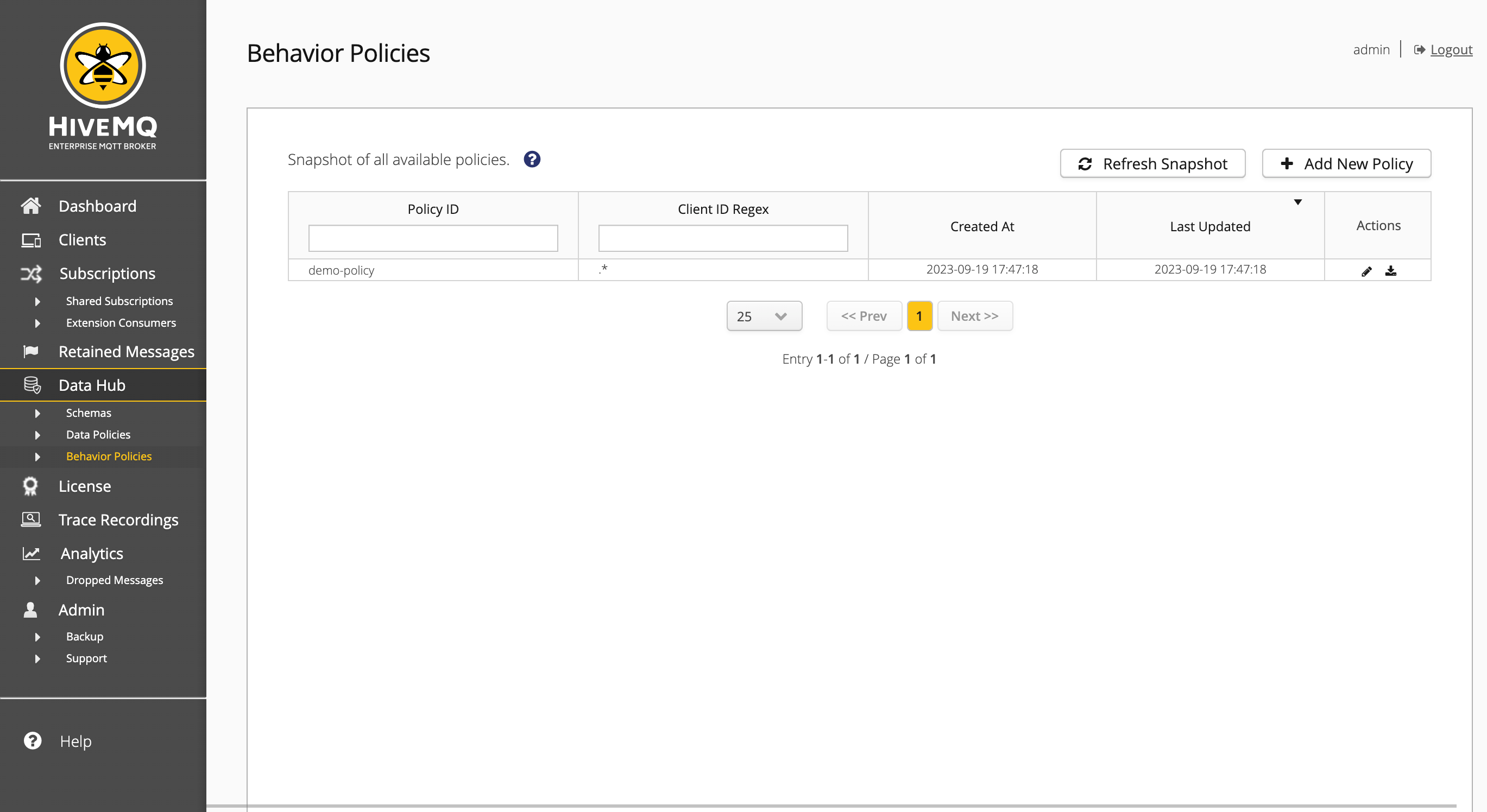
The list is sorted by Last Updated, such that the latest policy is always on top of the list.
Basic information is provided for each policy such as policyId,
clientIdRegex, and Created At.
Quick actions allow you to view, edit, or download the policy.
Edit Behavior Policy
To edit an existing behavior policy, select the ID of the desired policy in the Policy ID list of the Behavior Policies overview
In the Behavior Policy Detail that opens, you can manipulate the content of the policy:
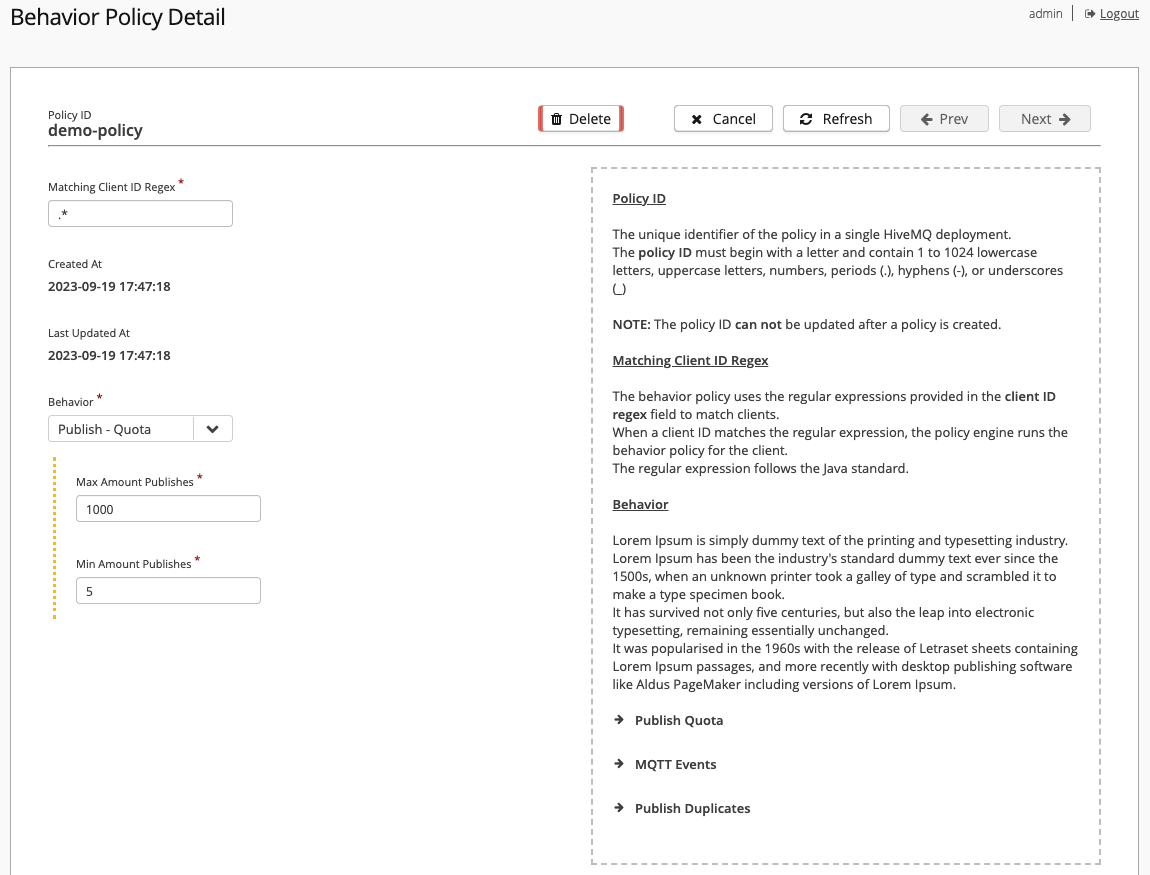
In the upper part of the dialog, the Policy Id, the Matching Client ID Regex and the behavior model can be defined.
However, after creating a policy, the policy Id cannot be changed.
After selecting a behavior model, arguments for each model can be configured.
Once the setup is complete, the transitions described in the section States & Transitions can be selected.
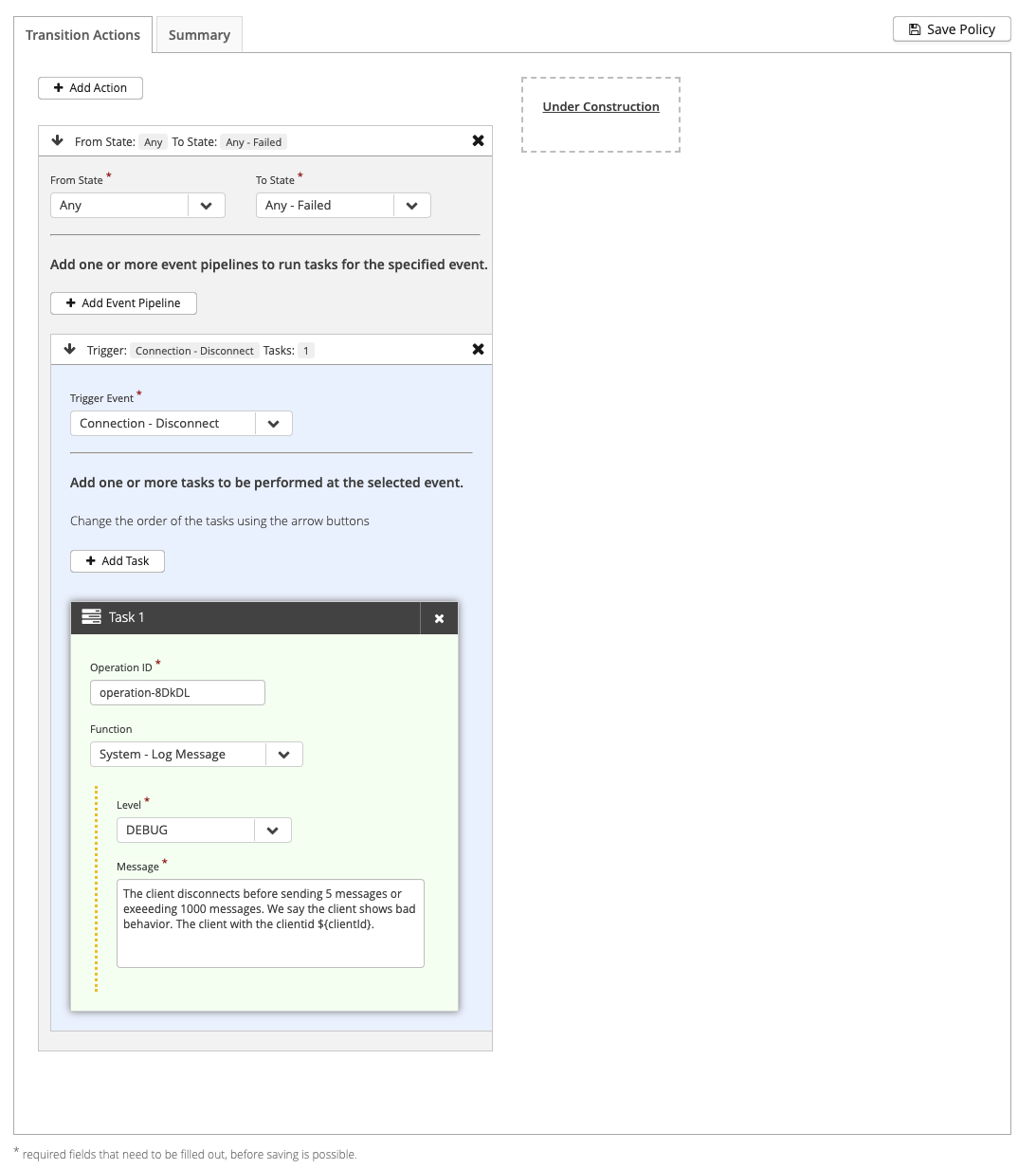
In the screenshot above, a transition from state Any.* to Any.Failed and the event Connection.onDisconnect is selected.
An action Log Message is executed with a customized log message.
A policy can only be saved if all required fields are properly filled.
When you create or edit a policy, a summary is provided for you to review before you save:
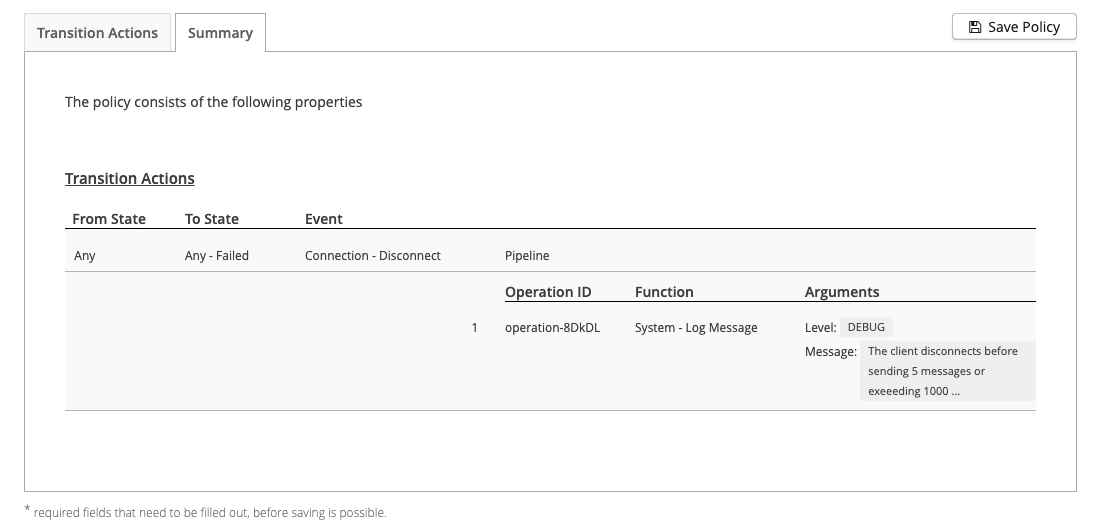
The summary provides a brief overview of what the policy implements.
Behavior Policy Management with the REST API
The HiveMQ Rest API provides the following methods to manage behavior policies for the HiveMQ Data Hub:
Create a new behavior policy
The fields in the body of the create a new policy HTTP request determine the type of policy that is created. For more information, see HiveMQ REST API.
| To create a new behavior policy, all cluster nodes must run HiveMQ version 4.20.0 or higher, and behavior validation must be enabled (default: enabled). For more information, see Data Hub. |
| Field | Type | Required | Description |
|---|---|---|---|
|
String |
The identifier of the policy. The ID must be unique within one HiveMQ cluster. |
|
|
Object |
Defines the matching rule of the policy. For more information, see Behavior Policy Matching. |
|
|
Object |
Describes which behavior model is instantiated. For more information, see Behavior Model. |
|
|
Array |
Defines a list of transitions on which further actions can be executed. For more information, see Behavior Policy Transitions. |
| Your HiveMQ broker automatically replicates the policies you create to all nodes in the HiveMQ cluster. |
{
"id": "example-behavior-policy",
"matching": {
"clientIdRegex": ".*"
},
"behavior": {
"id": "Publish.duplicate"
},
"onTransitions": [
{
"fromState": "Any.*",
"toState": "Duplicated",
"Mqtt.OnInboundPublish": {
"pipeline": [
{
"id": "count-duplicate-messages",
"functionId": "Metrics.Counter.increment",
"arguments": {
"metricName": "repetitive-messages-count",
"incrementBy": 1
}
},
{
"id": "drop",
"functionId": "Mqtt.drop",
"arguments": {}
}
]
}
}
]
}Behavior Policy Matching
The behavior policy matching has been described in Section Matching.
In Table REST API Behavior Policy Model the general object has been introduced. However, the following table defines the matching object:
| Field | Type | Required | Description |
|---|---|---|---|
|
String |
Defines a regular expression that matches client IDs that are checked by the defined policy. The regular expression is defined according to Java specification: |
Behavior Model
Each behavior policy instantiates a behavior model that is defined by the following fields:
| Field | Type | Required | Description |
|---|---|---|---|
|
String |
Specifies the identifier of the behavior model, for example, |
|
|
Object |
Provides additional arguments to the behavior model. Please check out the available arguments of the specific behavior model. |
Behavior Policy Transitions
According to the specified behavior model, further actions for each state transition can be executed.
These transitions and states can be defined as follows.
However, onTransitions is an array as introduced in Table REST API Behavior Policy Model, the items of the array are defined as follows:
| Field | Type | Required | Description |
|---|---|---|---|
|
String |
Defines the state from the transitions starts. See the definition of the behavior model for any further information. Any wildcard state is accepted here, see Wildcard States. |
|
|
String |
Defines the target state of the transition. See the definition of the behavior model for any further information. Any wildcard state is accepted here, see Wildcard States. |
|
|
Object |
Where any event from Supported Events to trigger the action. The value refers to a pipeline to be executed according to the actions. For more information, see Actions. |
Update an existing policy
The fields in the body of the update a policy HTTP request determine the type of policy that is updated.
The id of the policy and the request parameter policyId must match.
| Parameter | Type | Required | Description |
|---|---|---|---|
|
String |
The path parameter that provides the ID of the policy to update. This parameter must match the |
| When a behavior policy is updated, currently connected clients remain under the old behavior policy. Upon the next reconnect, the updated behavior policy applies. |
All properties of a behavior policy can be updated except the policyId.
The payload is identical to the create policy request.
Delete a policy
To delete a policy that is no longer in use, reference the policyId of the policy.
| Parameter | Type | Required | Description |
|---|---|---|---|
|
String |
The path parameter that provides the ID of the policy to delete. |
Get a policy
To view the content of an existing policy, you reference the policyId of the policy.
| Parameter | Type | Required | Description |
|---|---|---|---|
|
String |
The path parameter that provides the ID of the policy. |
|
|
String |
The query parameter that provides a comma-separated list of the fields to include in the response.
Allowed values are: |
Get state of behavior model
While connected, each client that a behavior policy checks has a certain state within a behavior model at any given time.
To request the state information of a particular client via the REST API, you reference the clientId of the client.
| Parameter | Type | Required | Description |
|---|---|---|---|
|
String |
The path parameter that provides the client ID of the client for which state information is requested. |
The Rest API returns a JSON object with an array of states denoted by items.
Each element has the following information:
| Parameter | Type | Description |
|---|---|---|
|
String |
Provides the |
|
String |
Provides the identifier of the behavior model the behavior policy uses. |
|
String |
Shows the state type of the current state. |
|
String |
Shows the current state name of the behavior model. |
|
String |
The datetime when the state in |
|
Object |
Provides the configured arguments of the behavior model. |
|
Object |
Provides the variables to determine the state of a behavior, if required. Variables can be used to offer more in-depth information. |
Publish.quota behavior model{
"items" : [
{
"policyId" : "duplicate-policy",
"behaviorId" : "Publish.quota",
"stateType" : "INTERMEDIATE",
"stateName" : "Connected",
"firstSetAt" : "2023-09-22T19:19:16.954Z",
"arguments" : {
"minPublishes" : 2,
"maxPublishes" : -1
},
"variables" : {
"minPublishes" : "2",
"publishCount" : "0",
"maxPublishes" : "-1"
}
}
]
}